The Duncan Home For Wayward Cats: Cat Tunnel System, Cat Green Room and Catairium
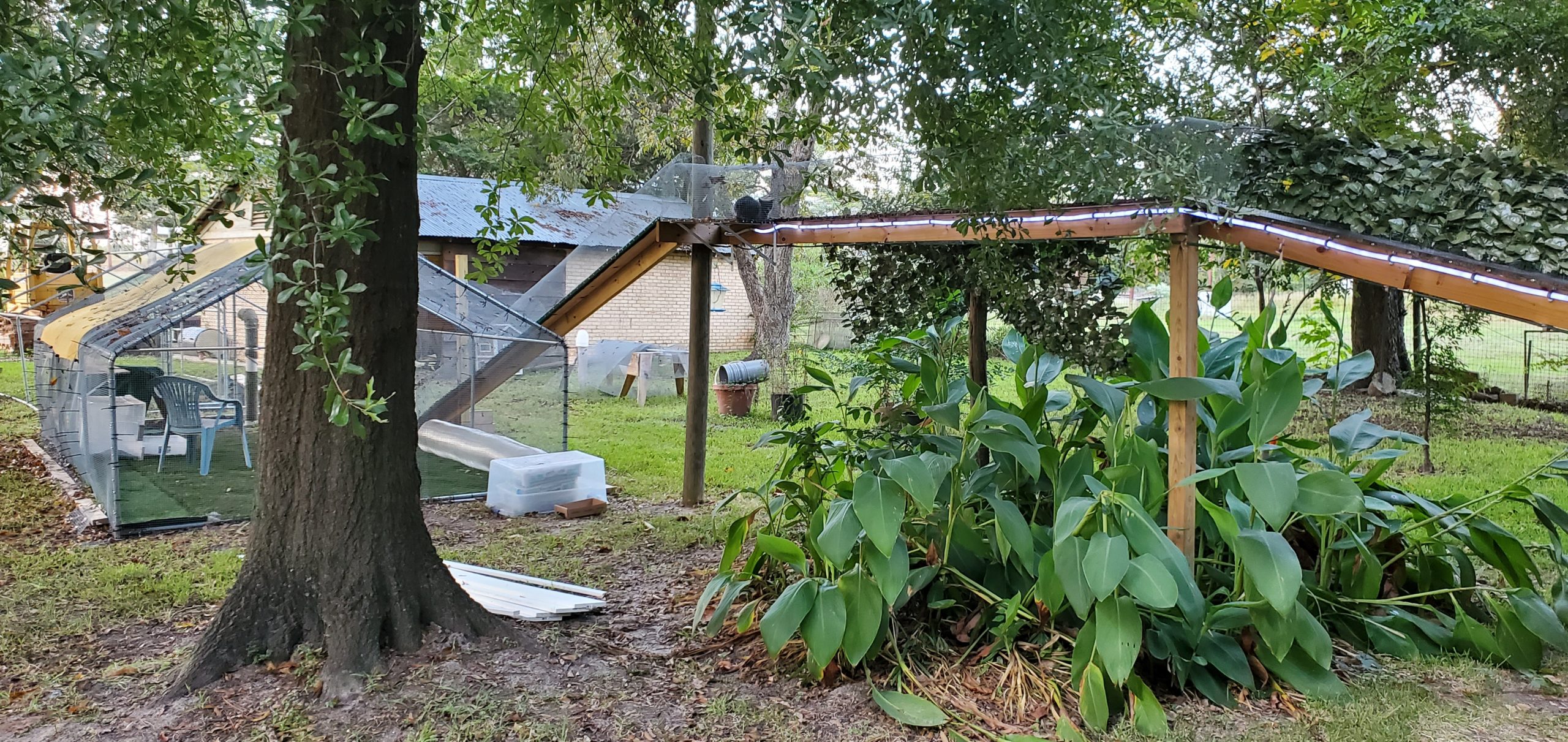
I never planned to have a herd of cats, but irresponsible neighbors who repeatedly failed to spay and neuter resulted in pregnant Queens bringing their babies to live with us.
Full disclosure, at our home we maintain three outdoor dry cat food feeders and four automatically filled water bowls for cats, opossums, raccoons, and birds. I think the birds eat as much cat food as the cats do. 🙂 So, it really is kinda my fault that hungry kitties migrate to our house and stay, but those who do will be spayed and neutered.
Then in 2021, to quote my sister, “…My brother accidentally started a cat rescue…” 🙂 That happened when I got involved with rescuing a colony of cats (The Henderson Cat Colony) abandoned by a neighbor who moved. I had no idea what I was getting into. Our cat count quickly got out of control while trapping, spaying, neutering, vetting, and trying to find homes for them.
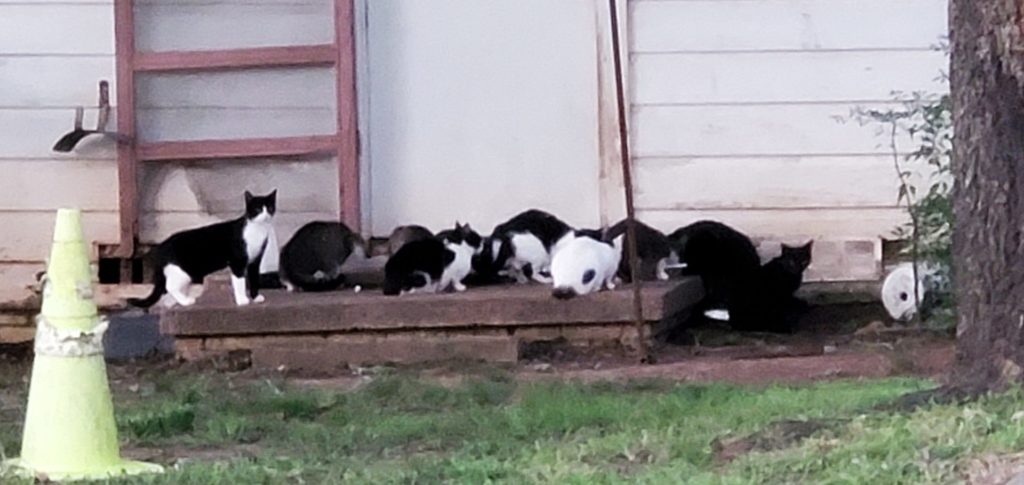
Fortunately, when the cat colony rescue began we had already completed the Tunnel System, Green Room, and Catairium for our resident cats, so we were able to accommodate additional kittens and socialized cats.
However, managing the feral colony cats required renovation of an additional building and the addition of about 20 kennels to hold cats temporarily after trapping and while they awaited surgery or while they healed from surgery or while they were being treated for medical issues, waiting for adopters to pick them up, etc.
Since the Henderson Cat Colony adventure began, over 85 cats have been under care at the Duncan Home For Wayward Cats seeking homes with 45 still in need of adoption as of 03/14/2022.
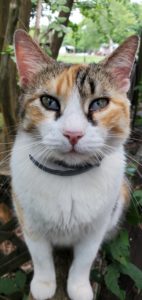
The primary reason that the Cat Tunnel System, Green Room, and Catairium were initially constructed was because of “Mama Kitty.”
Many years ago, one of the neighbor's cats (Mama Kitty) decided to take up residence with us as an outdoor cat; however, she was extremely territorial and every day she would start a fight with our outdoor cat. It got so bad that we temporarily rehomed the other cat (who also did not want to be an indoor cat) with a loving relative because Mama Kitty was feral and untrappable. When she was finally the only cat left on our property, then apparently she was happy. One day when I had my office door open enjoying the beautiful day, to my great surprise, without any enticement or coaxing, she suddenly entered my office and jumped up on my desk demanding to be stroked and petted. From feral to friendly in one day! 🙂
Attempts to transition her to be an indoor cat failed because apparently, she has decided that she must be the only cat; therefore, she became an indoor/outdoor office cat coming and going as she pleased. She walks the perimeter of her realm every day and deals out punishment to any interloper foolish enough to cross into her domain. She is road savvy and does not go near the road or cross it and she has figured out to avoid the neighbor's dogs that have killed one cat who made the mistake of crossing into their pasture.
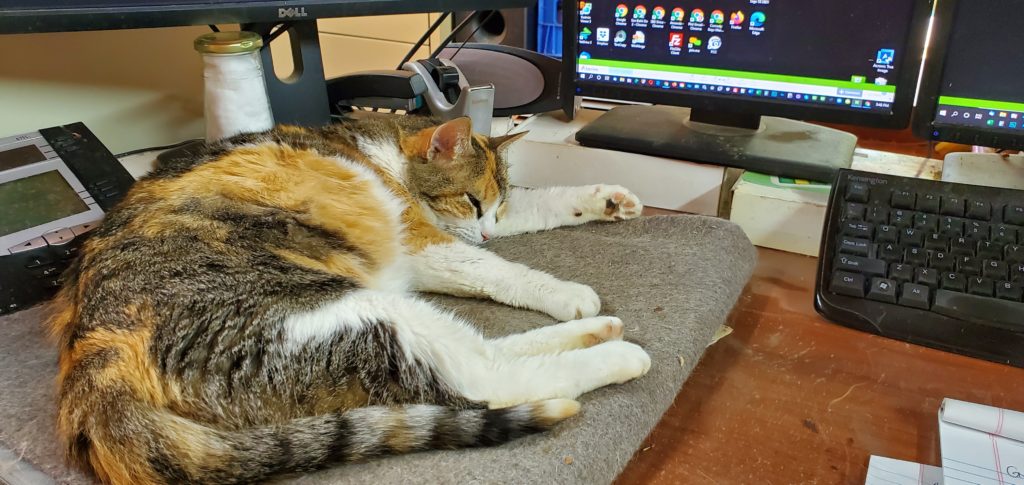
When not patrolling, she spends many hours of her days helping me in my office. 🙂
I mention Mama Kitty and her back story because she was the first cat that moved from our neighbor's yard to our house and she is the primary reason that all subsequent cats had to become indoor cats — or they would likely be frequent patients at the vet's office.
She was also the primary reason that the Cat Tunnel System, Green Room, and Catairium were constructed when other cats and kittens sought sanctuary in our yard.
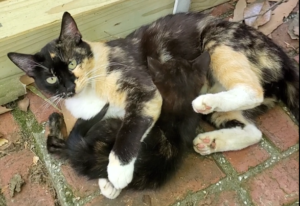
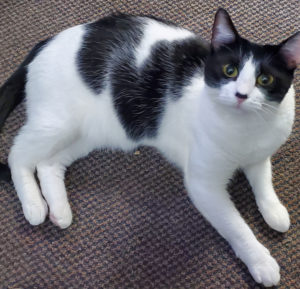
Our resident cat population first began increasing when two pregnant Queens (Drive and Tree) from the neighbor's house came to us because food and water were plentiful at our house and they were able to hide their kittens nearby until they finally brought them out for us to see. The kittens are a whole other story and lots more photos 🙂
The neighbor had about 13-15 cats running in the yard and were not spaying or neutering them and apparently not providing enough food and water for that many cats.
We maintain three outdoor dry food feeders that hold 25 lbs of dry cat food each and we have installed four automatic water bowls that are always full of fresh water. The 24/7/365 buffet and water bars are very popular. 🙂
However, when a cat partakes of the food, they are captured, spayed or neutered, vetted, and microchipped.
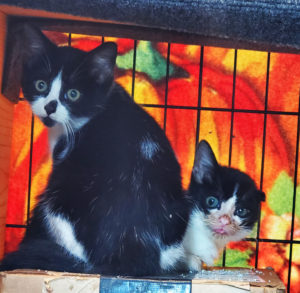
New arrivals are always sequestered in kennels until they get accustomed to the new environment and until they and the resident cats get used to each other's scent. When they all get to know each other, then eventually, new arrivals are released into the general population so they can have their freedom and avail themselves of all the cat amenities.
We have found that in most -but not all- cases, socialization accelerates when the cats are out of kennels. Those who remain confined in kennels for too long will get more and more angry and aggressive.
When we captured Drive and Tree and their kittens (all the same age) and brought them all inside, I did not want them to feel like little prisoners during the socialization process, so the house got made over with all kinds of cat enrichment from a plethora of cat toys, indoor screen doors on multiple rooms for segregation when needed, kitten playpens, scratching cactuses, climbing trees, wall mounted cat climbing shelves, cat condos, Litter Robots, and more.
I also wanted all the cats and kittens to be able to safely experience the outdoors and be protected from the death trap roadway in front of our house, the cat-killing dogs of the neighbor behind us, and safety from attacks by the warrior princess, “Mama Kitty.”
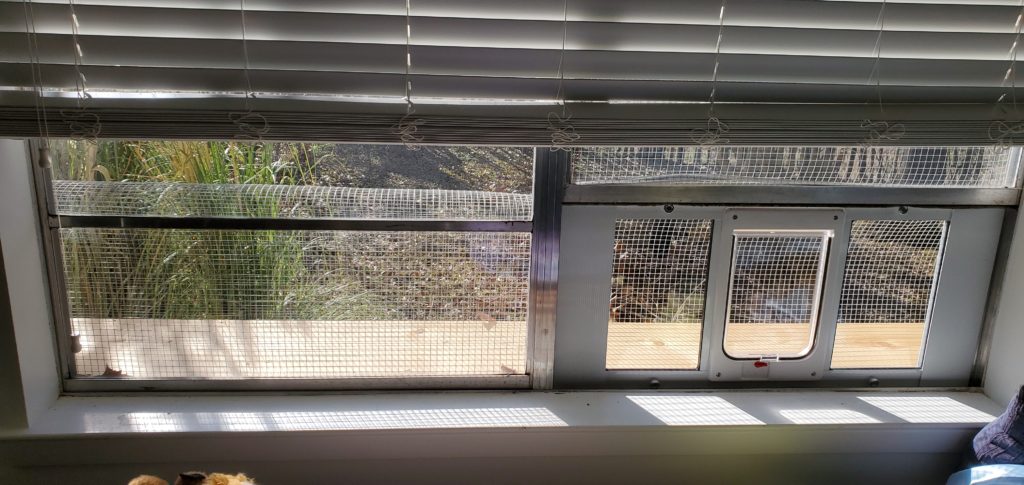
I decided to install a cat door that opened into a secure outdoor enclosure where the cats and kittens could play and lounge while watching birds and squirrels and experiencing the outdoors.
Step one was to test if the cats would even go through a cat door into a tunnel that allowed them to observe outdoor goings-on. You can never know what cats will, or will not, do. 🙂
We installed an Ideal Pet Products Aluminum Sash Window Pet Door in one window and connected the tunnel to it. It was a super quick installation with NO TOOLS and I was so impressed with it that we later installed six of them in various windows with all opening into the secure Tunnel System.
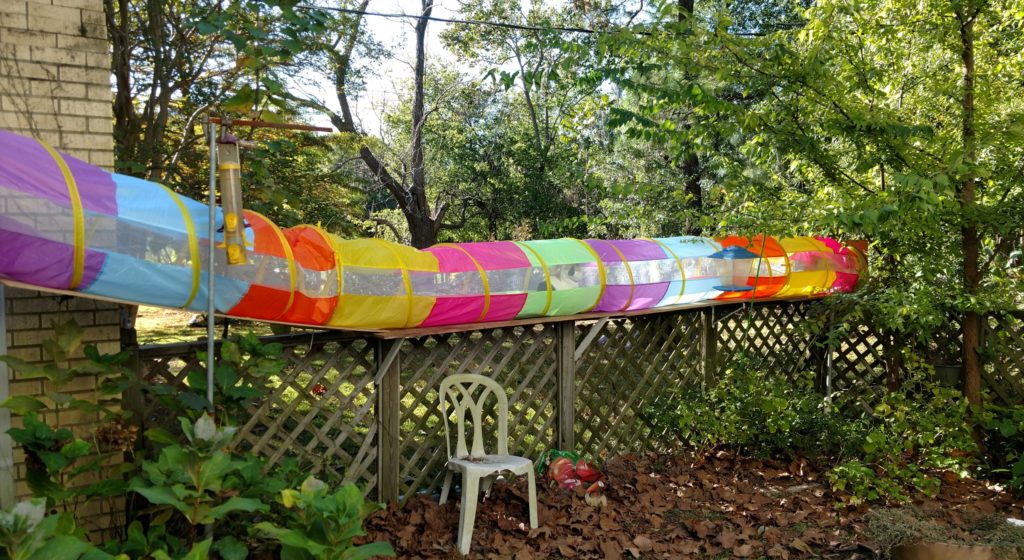
The prototype was a colorful test tunnel constructed quickly with the Hide N Side 2-Pack Tunnel (2 sets for 24 ft total tunnel), but a very temporary one as the nylon tunnel did not fare well under attack by Mama Kitty and other strays in the neighborhood when they saw the indoor cats inside the tunnel peering out at them,
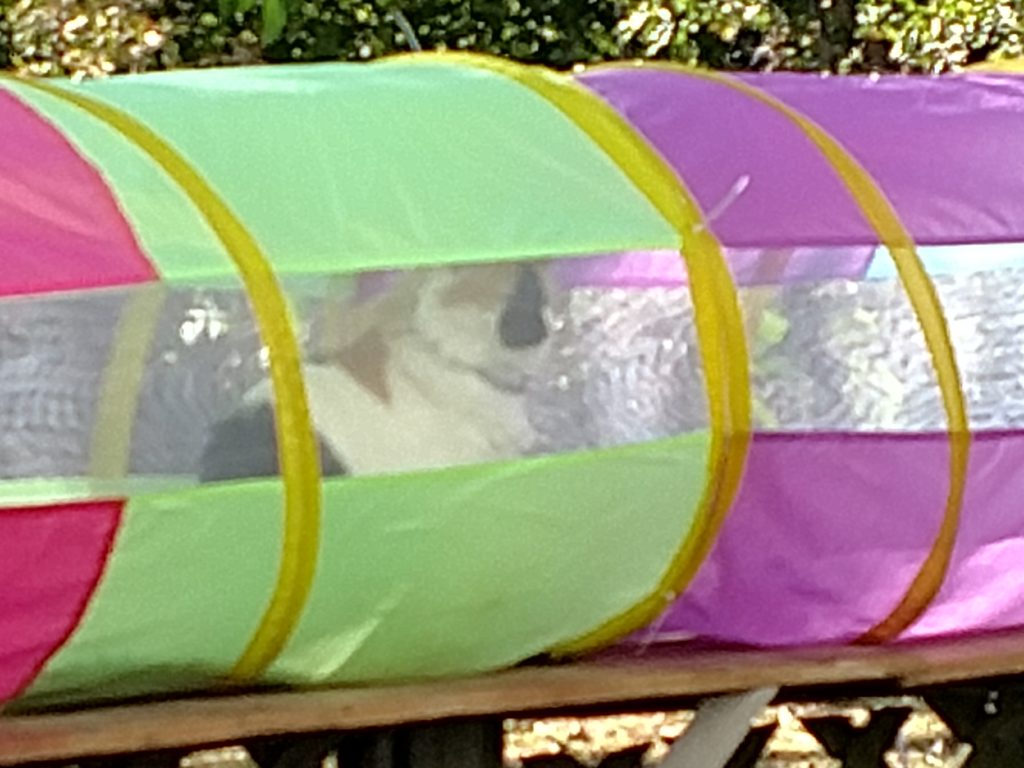
However, when nylon tunnels are placed inside the house, they are one of the most enjoyed cat toys.
They LOVE going through them and playing in them.
After purchasing dozens of different ones, the best value and most durable one we found is the Hide N Side 2-Pack Tunnel.
The next step was to design a more durable and secure tunnel enclosure that could contain the cats inside the tunnel and survive the attacks from the cats or predators outside the tunnel.
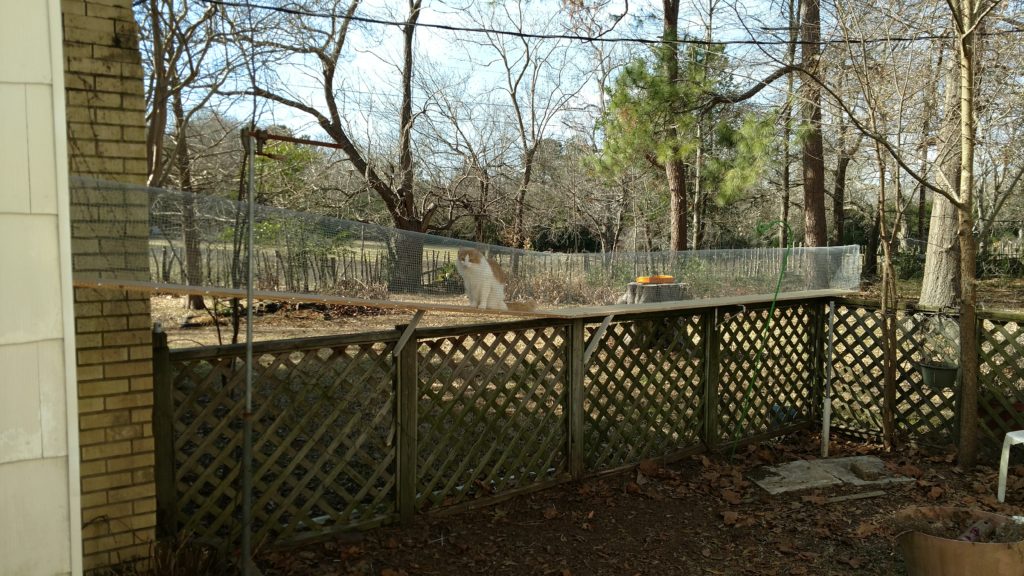
I deemed the openings in chicken wire to be too large as a paw could be inserted through those openings and that could be bad. It would be safer if the openings were too small for a paw to go through, so we chose the hardware cloth with 1/2″ openings.
There are lots of big stray cats, coyotes, raccoons, etc. in the area, so the tunnels also needed to be able to withstand any onslaught from those.
I had no idea how frequent and vigorous the onslaught from outside would be and from only ONE DAILY ANTAGONIST, “Mama Kitty.” 🙂
I wanted a tunnel system that was relatively economical and simple to construct. At that time 1 x 12 x 12 pine boards were about $18 per board now on 03/13/2022 they are $54 each. The 12ft tunnel sections were relatively easy to construct and assemble.
I settled on using 1 x 12 x 12 untreated pine boards as the tunnel flooring and 36-inch wire cloth with 1/2 inch openings screwed to each edge and shaped from edge to edge to form a tunnel.
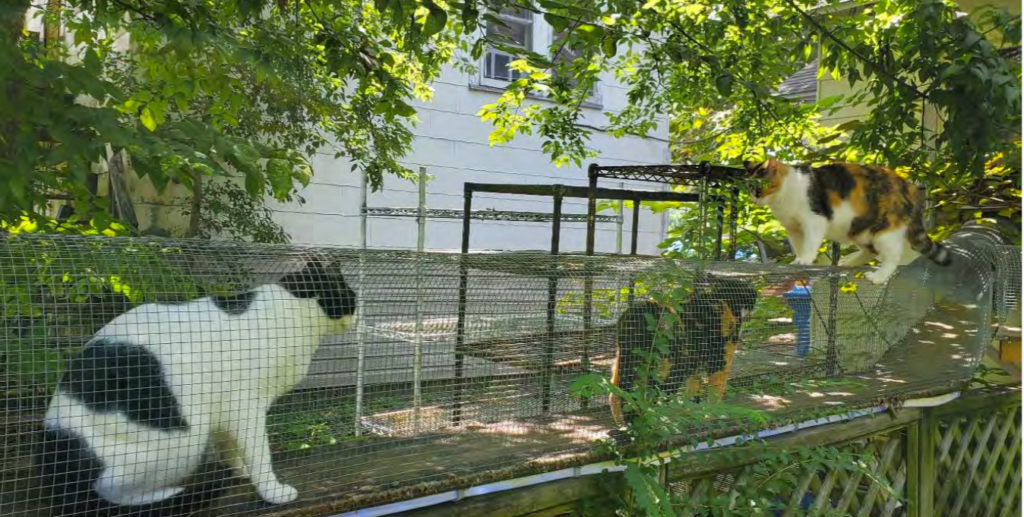
Weather treated wood was not chosen since the cats would be in direct contact with it and although untreated pine may deteriorate sooner over time, this was the most economical and quick solution. We did treat some sections with linseed oil before construction to evaluate how their durability compares to untreated sections over time.
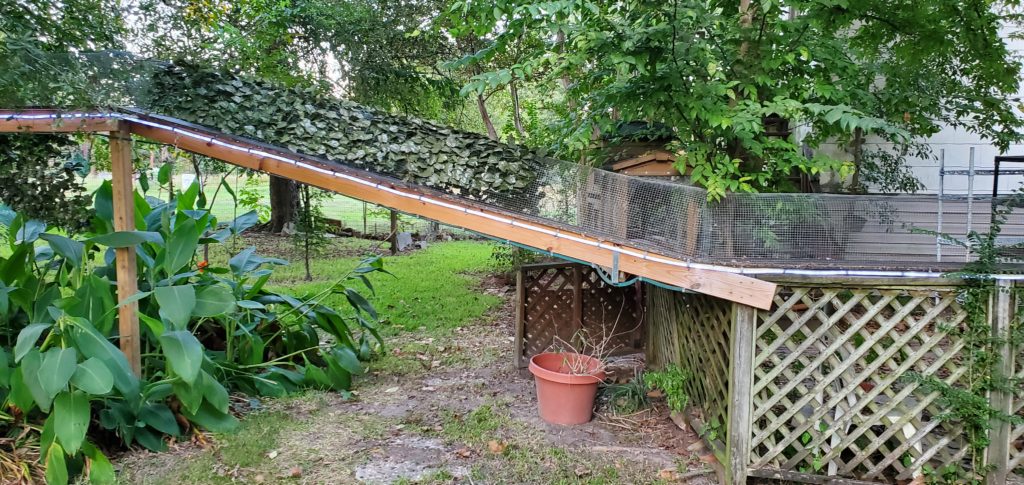
Only a few supplies are needed wood, wire, screws, and shelf brackets for mounting tunnel sections in some locations.
We used Teks Sharp Point (and some self-drilling) 1″ lath screws to secure the wire cloth to the edges of the 1 x 12 x 12.
When shelf brackets were needed we used heavy-duty 12 x 8 Home Master brackets. Cheaper and lighter duty shelf brackets are available, but not recommended, because several adults cats running and jumping about in the Tunnel System can result in hundreds of pounds of downward force, and some lighter duty brackets we tested collapsed. Not good.
We also choose to cover some of the 1 x 12 x 12 sections with green recycled outdoor rug material to provide some grip and a bit of insulation for the cat's paws from direct contact with the hot wood when in direct Texas Summer sunlight. We used the same material to cover shelving in the Green Room. Similar material is also available as a carpet or artificial grass from Lowes in 12 ft or 15ft widths. After those sections were covered, then the 1 x 12 x 12, wire cloth was affixed to each edge to form the tunnel.
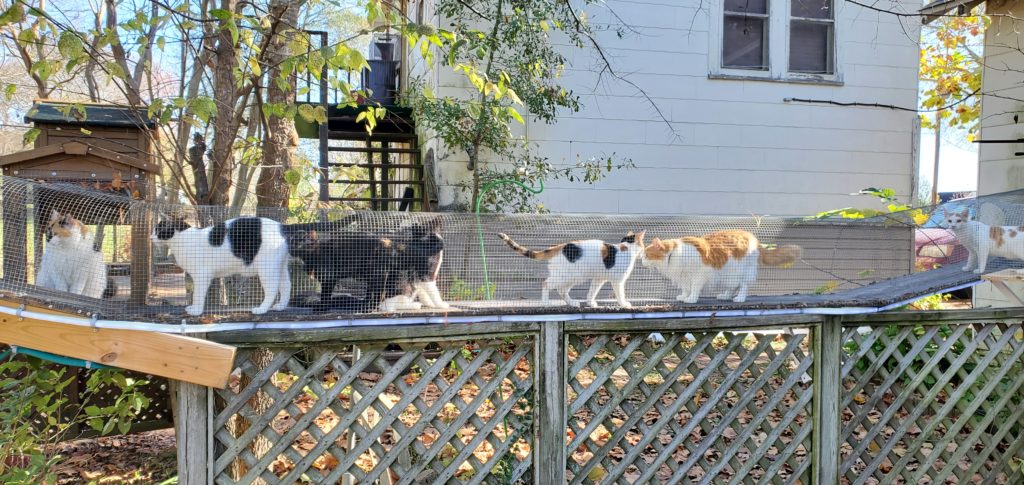
Assembly of the 12 ft tunnel sections is relatively simple and connecting them together is also relatively simple.
When the Tunnel System quickly proved to be far more popular with the cats than I had anticipated, we repurposed the greenhouse that is attached to the house and made it into a cat paradise (The Green Room) dedicated solely to indoor feline playing, climbing, and lounging.
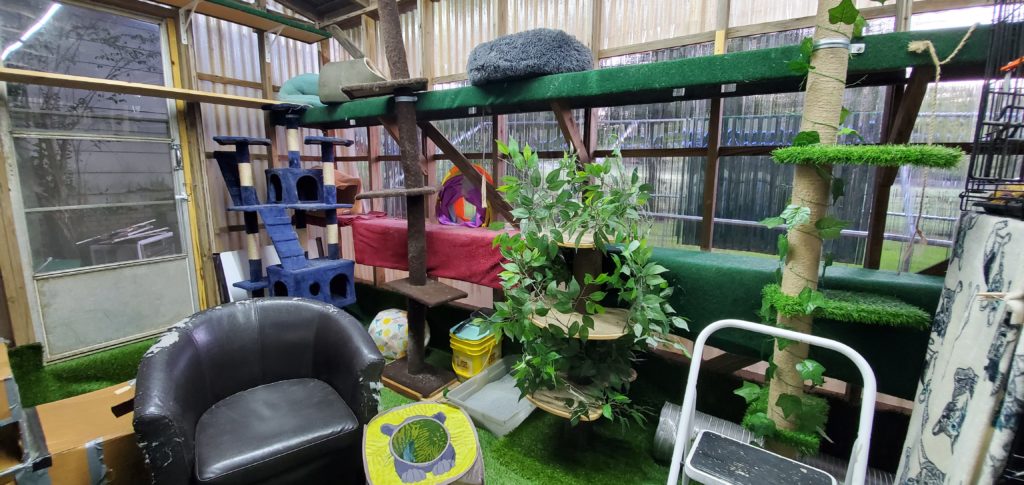
We installed a clear “window” viewing section from one end of the room to the other and a cat lounging shelf the full length of the room in front of the “window” plus lots of other shelves. The Green Room was wired with lots of electrical outlets, ceiling lights and soft white neon LED lighting for nighttime plus piped for water and gas.
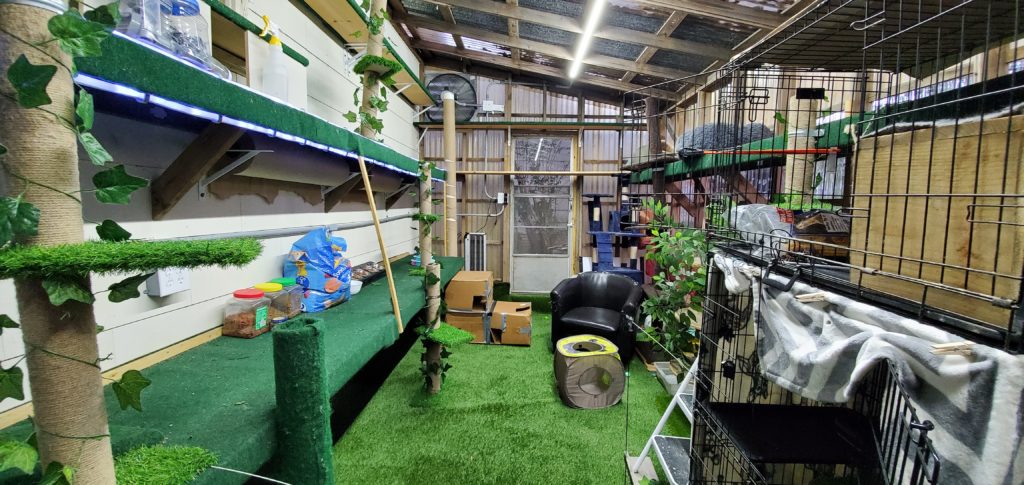
The Green Room was floored with artificial grass from Lowes, lined with lots of climbing shelves, equipped with multiple climbing trees and scratching posts, cat condos, a wide selection of cat beds, marshmallow beds, and several pet heating pads for cooler days. It also has a Litter-Robot, multiple litter boxes, feeding stations, and an automatically filled water station.
The Green Room also has a vent free 30,000 BTU radiant heater to keep the cold away on really cold days of nights and a temperature-controlled exhaust fan that comes on automatically when it gets too hot during the summer.
When Green Room renovations were complete, we connected the Tunnel System extension to the Green Room, so cats can enter and exit at will and go in or out of the main house through multiple cat doors.
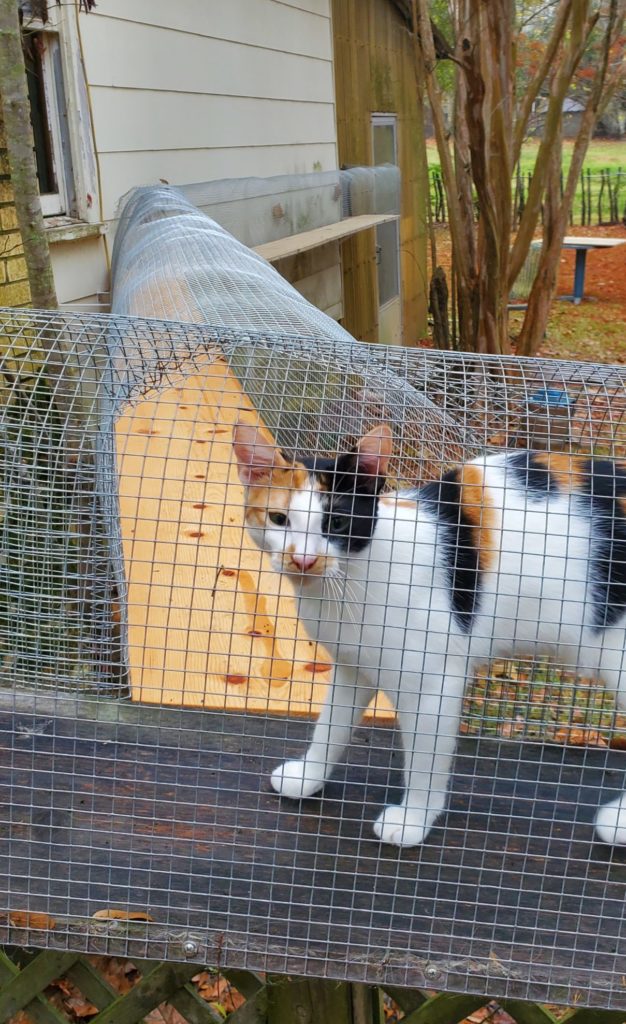
Allowing unsocialized cats and kittens outside was not an option for several reasons. Even after the Green Room was made accessible to them, I still felt they needed more open-air space and an outdoor experience.
The open-air Catairium was the next construction project.
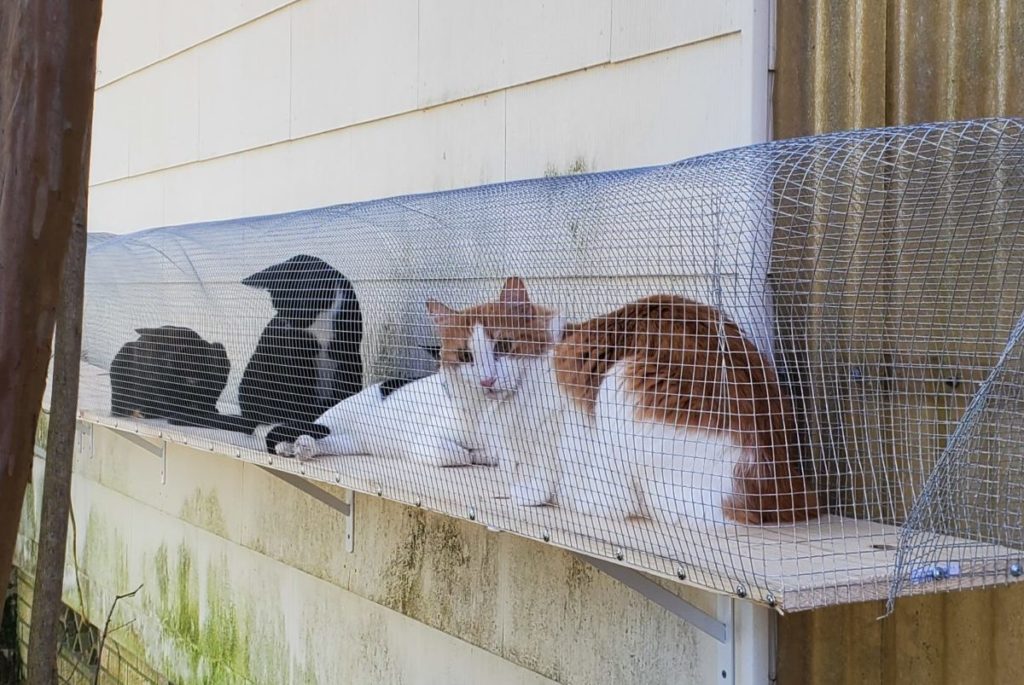
The secure Tunnel System connects from the main house to the Green Room and also to the Catairium and multiple rooms in the house so the cats can come and go as they please between them all and enter and exit the house at will while being safe and secure the entire time.
I also added nighttime lighting to the Tunnel System. I did not want it to be too bright or shining in the cat's eyes, so I chose flexible neon LED rope lighting and positioned it below the Tunnel System floor so that it softly illuminates the area without shining in the cat's eyes.
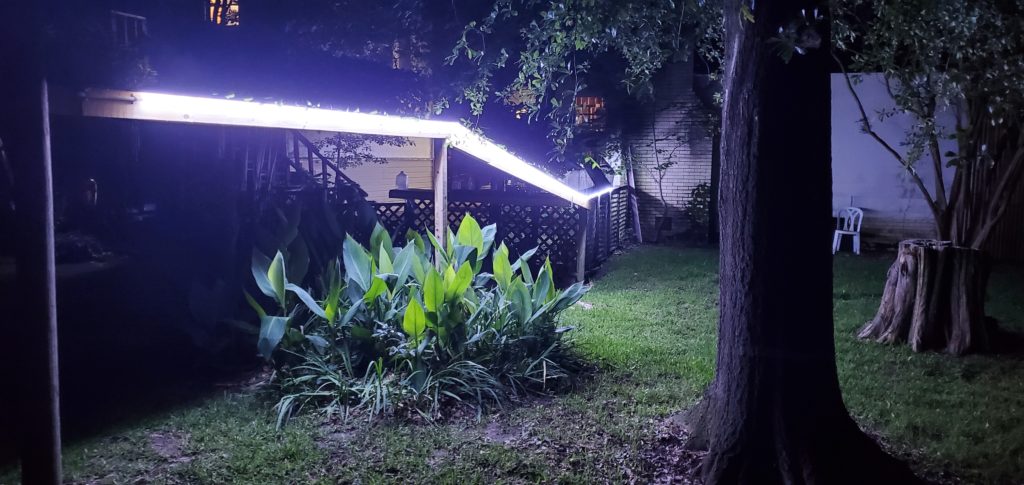
It also makes a great night-light for the Green Room and you can see some of it in the Green Room photos on the left-hand side down a shelf edge.
It's also great on the outside Tunnel System for humans stumbling through the yard at night. 🙂
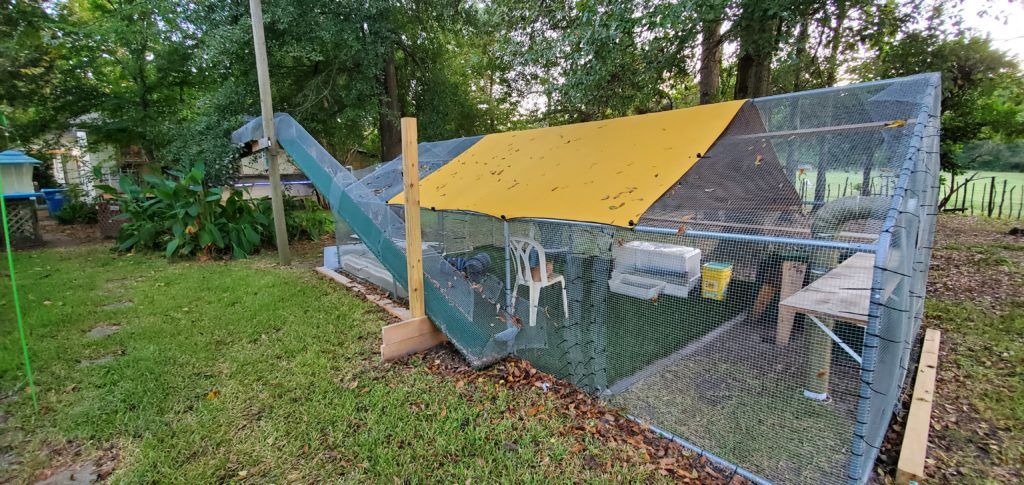
Creating the outdoor Catairium enclosure presented a number of challenges and some realizations that required adaptations as construction proceeded.
- I wanted the cat experience to be close to open-air as possible
- The structure needed to be strong and durable, but not permanent in case it needed to be moved.
- It needed a doorway big enough for a human to enter the structure.
- For the first 3 Catairiums we chose this 10′ x 20′ Chicken coop structure, but for the other eleven (11) catairiums we chose this 10′ x 20′ Chicken coop structure because the shape provided much more headroom for humans. On both versions we used 48″ hardware cloth with 1/2 inch openings to cover it rather than the chicken wire that came with the enclosure kit.
- It needed a roof capable of supporting the weight of critters if they decided to get on top of it. (enough strength is provided by hardware cloth)
- It needed to connect to the tunnel system so cats could enter and exit at will
- I did not want a full roof covering that would block their view for watching birds and squirrels.
-

The Breakfast Club members meet regularly in the Catairium It needed at least a portion of the roof covered to provide shade from the Texas sun.
- It needed a portion of the roof covered to shield rain and allow for an outdoor litter box under that roofed area.
- For the first 3 we chose to test using a 10 x 12 canvas tarp from Tractor Supply. (The small polyethylene tarp that came with the kit, shredded itself in a few months.)
- For catairiums version 2.0, all 14 were fitted for partial coverage using a variety of sizes of 20 mil thick white tarps from Lowes. The white tarps allow lots of light through, but still provide shade from the sun. Highly recommended.
- When the structure is placed too far under trees, then fallen leaves and limbs accumulated on the roof which created upkeep work to remove them, so it was better positioned where shade from trees covered it for part of the day rather than the limbs of the tree all day.
- It needed a feeding station. We opted for the Pet Lodge 25 lb Chow Hound and added a magnet to hold the door open.
- It needed an automatic water bowl to provide plenty of hydration, especially on hot summer days. I could not find a heated water bowl with an automatic fill feature, so during winter, I added pipe heating wrap to the underside to prevent the water from freezing.
- For version 2 catairiums I finally found this heated auto-refilling water bowl to be a better all-in-one solution.
- It needed a water source for cleaning the unavoidable toilet “accidents”
- It needed electricity for lights, water bowl heating wrap, heating pads, etc.
- It needed cat climbing shelves, climbing trees (must be dry under tarp) and lounging perches
- It needed an outdoor, weatherproof scratching post. (Had to be custom made)
- We 1st tried placing the structure over thick San Augustine grass and learned quickly that was not an option. The cats scratching and toileting quickly killed the grass and left only dirt. One of the cats even got an upper respiratory infection from scratching and sniffing the dirt looking for a toilet spot, so flooring became a must.
- It needed some kind of flooring to replace real grass and to minimize the possibility of fleas and ticks. Treating 40+ cats for fleas and ticks every month would cost far more than the one-time cost of the flooring. Of course, we still carefully monitor for any signs of fleas and ticks, but our experience has been that once eliminated and under control, monthly treatment of animals individually is superfluous.
-

Weatherproof outdoor litter box on left and positioned under the partial roof tarp. Not a drop of water has ever gotten in it. The smaller bin in front of it was temporary. It also needed flooring to prevent cats from digging in the real grass to potty. When they did that, the grass was killed and only dirt remained. We needed them to use the weatherproof outdoor litter box provided for them in the enclosure.
- It also needed flooring to prevent cats from rolling in the dirt and then entering the house covered in sand, etc. We tested real grass in a small section of the enclosure, but that was problematic so a full floor covering was needed.
- I wanted the flooring to provide the cats an outdoor experience, so we selected artificial grass from Lowes to provide that experience. The same artificial grass was used for the Green Room floor. Artificial grass is low maintenance, durable, and catclaw-resistant, it also allows easy cleaning of “accidents” and it isolates the cats from contact with the ground thus dirt and minimizes or eliminates fleas.
- Mosquito control: When the outdoor Catairium was first opened to the cats I sat inside with them and watched their behavior to see if they found cracks, crevices, or possible escape routes that I overlooked. When dusk arrived, I was almost eaten alive by mosquitos. That made me realize that the cats would also be easy meals for these blood-suckers so I needed to do something. Treating 40+ cats monthly with preventative medicine would be prohibitively expensive and the cats may still be getting bitten, so we decided to test a more economical solution that would get rid of the mosquitos on our property and thus prevent cats from being bitten rather than treating cats individually. I did not know if the TRUGREEN MOSQUITO DEFENSE treatment would work, but it did! Their treatment plan completely eliminated mosquitos from our property. AMAZING! The cost for this was far less expensive and far less trouble than administering monthly medicines to 40+ cats.

The Catairium quickly became the most popular cat hang-out of all.
In the next phase, we are expanding the secure Tunnel System to connect to the 20 x 30 brick shop you see in the photos. It has already been converted to a feral cat room containing food, water, climbing trees, kennels, climate control, and a wireless video camera to monitor occupants. It currently houses four feral colony cats who are pending rehoming.
You can scroll through this document for other photos of the Duncan Home For Wayward Cats. 🙂
duncan-home-for-wayward-cats-catairium-and-green-room-small
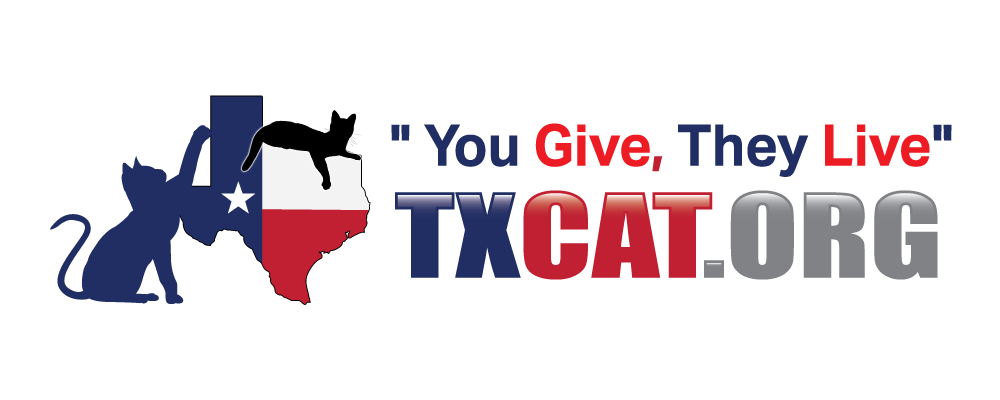
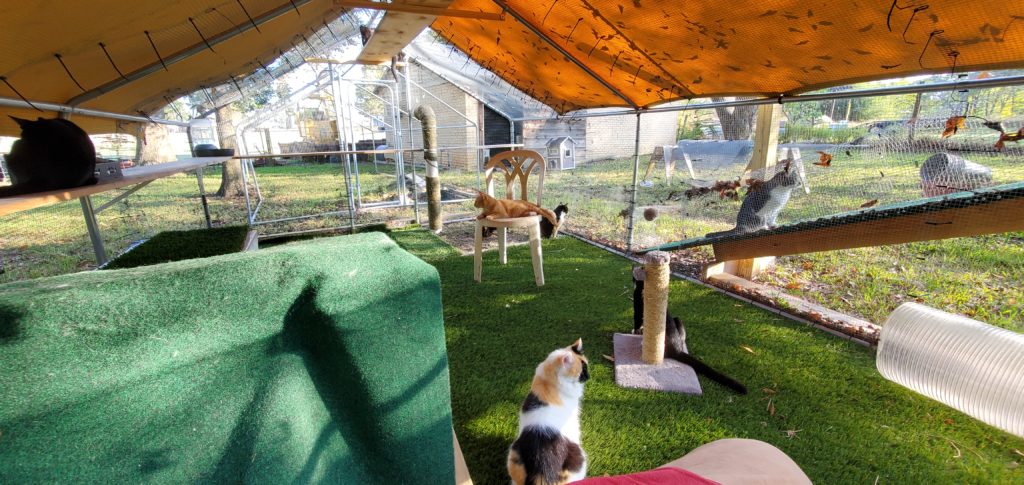
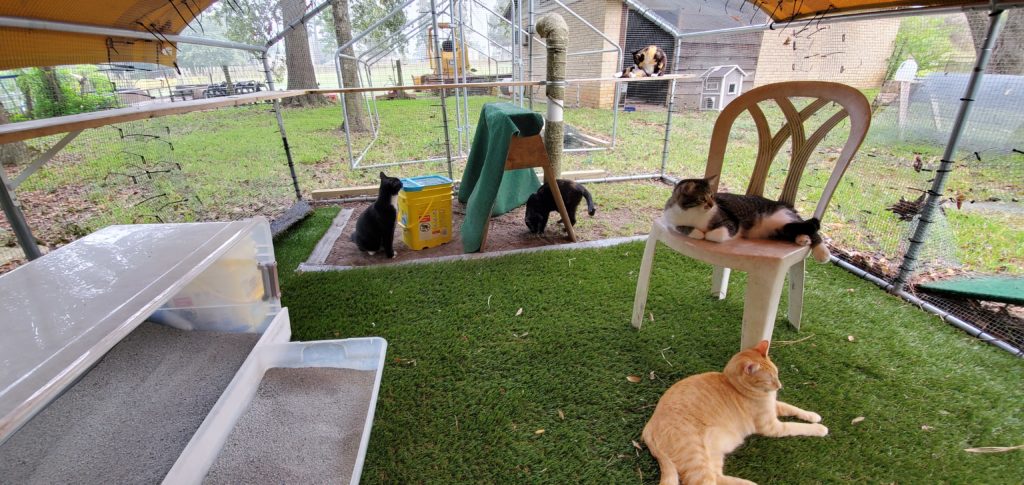
2 Comments
I have 4 cats that need rescue. I’ve exhausted all avenues. They are outside cats that neighbors aren’t taking care of. Stripes 3 yr old male nutered. Shadow 2 year old female spayed. 3? Year old female. Little Morris 4 mos old kitten. Sex unknown. We move in 10 days and they will starve without us! Please help!
I have a 12 week old kitten found in the middle of a busy street. My cat and dogs wants to kill her so she doesn’t get much time out of the kennel while I look for a rescue. I’ve dewormed and bathed her. She is healthy and eats well. We are 10 mins from Henderson off 79. Do you have any room? She desperately wants a playmate.